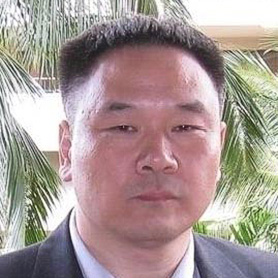Dr. Jinyuan Wu
Engineer II, III, Particle Physics Division Fermi National Accelerator Laboratory
Lectures
Conventional and Unconventional Applications of Field-Programmable Gate Arrays
Conventionally, Field-Programmable Gate Arrays (FPGA) devices are used either as glue logic, in which the FPGA device interfaces between a number of conventional integrated circuits, or as a data interface. However, the full potential of the FPGA extends well beyond these conventional applications. In this presentation, several topics, loosely categorized into “unconventional” applications, are discussed. The examples are extracted from real high energy physics applications, including a time-to-digital converter (TDC) implemented purely with FPGA, an analog-to-digital converter (ADC) using FPGA TDC and passive components, waveform digitization, data compression, filtering and reconfigurable computing in FPGA. Some examples are discussed in a book authored by the lecturer: “Applications of Field-Programmable Gate Arrays in Scientific Research” (Taylor & Francis, 2010), while others were newly developed after publication of the book. The presentation is intended for a general physicist/engineer audience.
FPGA Based TDC: A Convenient Digitization Scheme and its Applications beyond Time Measurements
Time-to-digital converter (TDC) was developed in application-specific integrated circuits (ASIC) and in recent years it can be implemented purely with FPGA. Once the digitizers are implemented into the FPGA that collects data, system flexibility is significantly increased while the cost is reduced. The applications of FPGA TDC are not limited to the time measurements. With appropriate signal conditioning, the FPGA TDC can be used to digitize signals in analog domain, ranging from regular continuous analog-to-digital converter (ADC) to pulse time and charge measurements. In this presentation, the FPGA TDC schemes will be briefly reviewed and then the primary focus will be on the various examples of applications such as high channel count ADC, small current measurement, pulse time and pulse shape digitization, etc.
Tracking Triggers in High Energy Physics Experiments
Charged track parameters such as momentum and angles have been important event selection primitives since the early age of experimental high energy physics. Nearly all high energy physics experiments have a trigger system based on coincidence of detector elements and the conditions of the coincidence usually cause certain constrains on the track parameters implicitly. In this sense, tracking triggers have existed for decades.
Driven by physics requirements, detectors in accelerators such as LHC see very high hit rate with possible pile up of 200 interactions in each beam bunch crossing. The challenges of contemporary tracking trigger systems include encoding and transmitting detector hit information into trigger processors, matching hits into potential tracks and using the coordinates of the hits in track fitting process to calculate the track parameters as the trigger primitives.
In this presentation, these challenges will be explained through several examples of both legacy experiments and on going new R&D projects. Various schemes of solving these challenges will be described and their advantages and disadvantages will discussed.
About

Education
* Ph.D. in Experimental High Energy Physics, Department of Physics, The Pennsylvania State University, U.S.A., 1992
* M.S. in Micro-Electro-Ultrasonic Devices, Institute of Acoustics, Chinese Academy of Sciences, Beijing, China, 1986
* B.S. in Space Physics, Department of Geophysics, Peking University, Beijing, China, 1982
Recent Short Courses Presented
* “FPGA Applications for High Energy Physics.” Institute of High Energy Physics, Beijing, China, Mar. 2010
* “FPGA Structure, Programming Principals and Applications.” 2009 IEEE-NPSS Real Time Conference, May 2009
* “Digital Design with FPGAs: Examples and Resource Saving Tips.” 2007 IEEE Nuclear Science Symposium, Oct. 2007
Book
“Applications of Field-Programmable Gate Arrays in Scientific Research.” Hartmut F.-W. Sadrozinski & Jinyuan Wu, Taylor & Francis (2010)